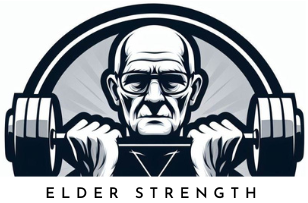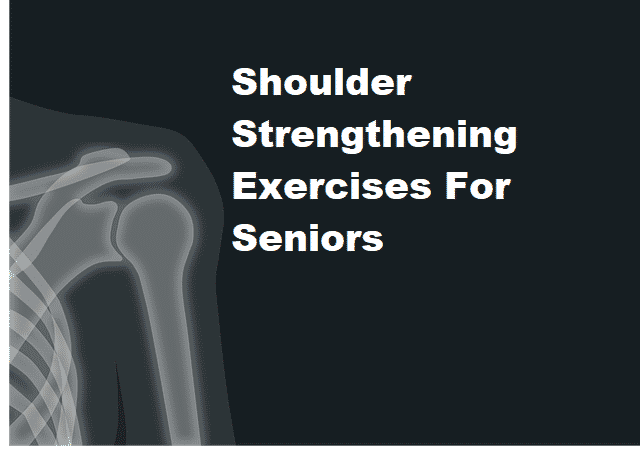Welcome! In this post, you will learn about the best shoulder strengthening exercises for seniors.
The shoulder joint is the most complex and mobile joint in your body. It moves virtually in all directions and also rotates.
While this is essential for the nimble use of our arms and hands, it, unfortunately, makes the shoulder very susceptible to injury.
The health of your shoulder joints is highly dependent on the strength of the surrounding muscles and the strength and mobility of the tendons and ligaments around the joint.
Besides the large deltoid shoulder muscles, there are very small muscles around the joint that form a structure called the rotator cuff.
The rotator cuff is responsible for stabilizing the shoulder joint and The rotator cuff is especially prone to injury if the shoulder muscles are not strong.
One of the things that makes the smaller shoulder muscles prone to injury is the fact that the largest and strongest muscles of the upper body, mainly the pectorals and large back muscles also move the shoulder joint.
When you push or pull a heavy load with your arms, these muscles put an enormous load on the shoulder joint. If the stabilizing muscles around it are not strong enough this can lead to injuries like tears and inflammation.
The good news is that it’s easy to strengthen these muscles and that you don’t really have to understand the anatomy to do so.
The bad news is that if you already have joint pain from injuries and wear and tear, you will likely need to consult a physiotherapist and not try to strengthen your shoulders on your own.
Prevention is key with shoulder injuries, so it really pays to include shoulder strengthening exercises in your routine.
Let’s look at the exercises for strengthening the shoulder joint.
Shoulder Strengthening Exercise For Seniors
Before we look at the exercises a quick word about shoulder training and special considerations for seniors.
Because the shoulder is such a fragile joint, shoulder training should always prioritize stability and mobility over absolute strength.
This means that the focus should be on performing exercises with a full range of motion and with correct form. If you lack mobility in the shoulder joints, the focus should be in improving that first.
Even young people often suffer from postural issues that can affect the stability of the shoulders. This includes rounded shoulders, slouched upper back, forward head and neck, tilted pelvis etc. This is also true for seniors, who have had more time to develop these postural issues.
That’s why it’s also important not to focus simply on the shoulders but on your whole body. This starts with having good posture as I talked about in the article Good Posture Exercises For Seniors.
Seniors tend to suffer more from shoulder issues as they have much more miles on the joints so to speak. The wear and tear from decades of use
Shoulder stability training is also very important if you are a senior strength athlete and participate in powerlifting, CrossFit, or bodybuilding. It will help keep your shoulders healthy and pain-free during heavy presses.
With shoulder training, it’s especially important to start right, learn the correct form, and build strength over time. You can learn more about shoulder training in the article Shoulder Exercises for the Elderly.
But the basic principles of strength training apply. You learn more about these in the article Benefits Of Strength Training For Seniors.
Exercise 1: Upright Shoulder Rotation
Because the rotator cuff is so prone to injury I want to start with my favorite rotator cuff exercise. The upright shoulder rotation.
The upright shoulder rotation involves rotating your shoulder with your arms at your side horizontally with the forearm perpendicular to the upper arm.
When you start out with these exercises, you can do them without any weight as the weight of the forearm is enough resistance.
As you improve your strength, you can add very little weight like a small water bottle or a 1 to 2 lbs dumbbell. With the rotator cuff, it’s better to focus on perfect form with less weight and add repetitions.
Over time this will build strength, durability, and stability in the rotator cuff so it can support the shoulder joint while the larger deltoid muscles do the heavy lifting.
Here’s a great video by HASFit on YouTube showing the exercise.
Exercise 2: Side Lateral Raise
The second exercise for the shoulders is side lateral raises. The side lateral raise is especially effective for strengthening the lateral deltoid muscle, which is the largest and strongest deltoid muscle.
The side lateral raise can be performed with any kind of external weight that’s the appropriate weight for the exercise. For most seniors, this means very light dumbbells, light Therabands, or an improvised lightweight like a water bottle.
The lateral raise should be started with very light weights, as the moment arm relative to the shoulder joint is very long, especially if you keep your arms completely straight.
It doesn’t take much weight to really feel it and you can even start simply by lifting your ar straight at your side, like imitating to flap wings.
If you use too much weight, it’s very easy to cheat by pushing with your hips to give the weight a bit of speed. This will put a lot of strain on the shoulder joint if it’s not stable and strong enough to handle the weight.
So start light, build up the strength slowly and see how your shoulder strength improves dramatically over time.
The side lateral raise is also great for the rotator cuff, which is another reason to start light so that the rotator cuff has time to adapt to the increased loads.
Here’s a great example of how to perform the movement by Fitness Buffhq on YouTube.
Exercise 3: Rear Lateral Raise
The third exercise is the rear lateral raise. As you might have guessed by the name, the exercise is very similar to the side lateral raise.
The rear lateral raise can be a bit difficult for seniors with back problems, as it’s typically performed in a bent-over position. It can be performed standing up or sitting down. Sitting is probably safer for most seniors as the risk of falling is much lower.
The idea is the same as with the side lateral raise. You raise your arms to your side but in this exercise, you raise them in a different plain, towards your back.
This will focus the load on your rear deltoid. The rear deltoid is very important for the stability of the shoulder joint as many people have significantly stronger front and side deltoids compared to it.
Just like with side lateral raises, the rear lateral raise can be performed with light dumbbells or improvised weights like water bottles. You can do one arm or both arms at a time, it doesn’t really matter as long as you train both arms.
With a Theraband or a light resistance band, it’s possible to perform the exercise standing up by holding the band in front of you about shoulder-width apart and pulling your arms apart until they are straight to your side.
If you perform this exercise with the band, it’s very important to use a very low resistance band as the pull of the band will be surprisingly heavy as the stretch is quite long.
This exercise is also great for stabilizing the scapula, which is important for upper body posture and shoulder stability.
Here’s a great example of the rear lateral raise by Girls Fone Strong on YouTube
Here’s a great example of rear delt resistance band pull by Brian Abelson on YouTube
Exercise 4: Overhead Press
Finally, let’s look at a functional compound movement that uses the shoulder muscles. The overhead press.
Any time you lift something overhead or reach for something on the upper shelf, you will benefit from the strength built with the overhead press.
The overhead press is a very effective shoulder exercise that utilizes all of the shoulder joint muscles but it especially uses the front and the side deltoids.
The overhead press, also known as the shoulder press, can be performed with dumbbells, barbells, or improvised weight.
A good way to start the overhead press for seniors is by using a gymstick or a broom handle for seniors. Most people, especially seniors lack the mobility and strength to perform the overhead press correctly with weights.
The good news is that using the previous exercises to build strength in your shoulders will help to improve the mobility and strength of the shoulders.
But the truth is that it might require extensive mobility work on the upper back and even the hips to be able to correctly perform a weighted overhead press.
That’s why I recommend you only learn it with an experienced trainer who can assess your mobility and form.
You can learn more about the overhead press in the article Shoulder Press For Seniors.
Conclusion
I hope you found this post about shoulder strengthening exercises for seniors useful. If any questions came to your mind, you can leave them in the comments section below and I’ll do my best to answer them for you.
As a recap, the shoulder joint is very complex and fragile so making it stronger is important for shoulder health.
The focus should be on building shoulder stability and good posture above absolute strength because the risk of injury is high.
With consistent training, it’s possible to improve shoulder strength and stability considerably which will help to prevent injuries and pain.
It’s important to remember that we are all individual and as we age the individual considerations increase. That’s why it’s wise to plan your workout routines with a medical professional.
Thanks for reading and see you next time!

